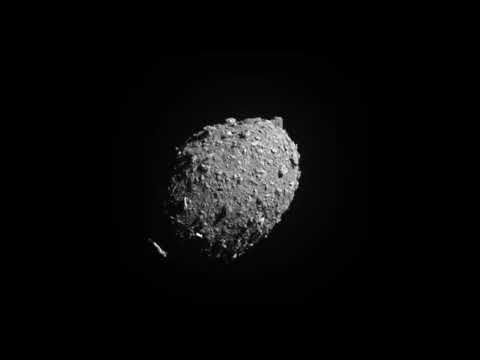This article was originally featured on Undark.
On a fall evening in 2022, scientists at the Johns Hopkins University Applied Physics Laboratory were busy with the final stages of a planetary defense mission. As Andy Rivkin, one of the team leaders, was getting ready to appear in NASA’s live broadcast of the experiment, a colleague posted a photo of a pair of asteroids: the half-mile-wide Didymos and, orbiting around it, a smaller one called Dimorphos, taken about 7 million miles from Earth.
“We were able to see Didymos and this little dot in the right spot where we expected Dimorphos to be,” Rivkin recalled.
After the interview, Rivkin joined a crowd of scientists and guests to watch the mission’s finale on several big screens: As part of an asteroid deflection mission called DART, a spacecraft was closing in on Dimorphos and photographing its rocky surface in increasing detail.
Then, at 7:14 p.m., a roughly 1,300-pound spacecraft slammed head-on into the asteroid.
Within a few minutes, members of the mission team in Kenya and South Africa posted images from their telescopes, showing a bright plume of debris.
In the days that followed, researchers continued to observe the dust cloud and discovered it had morphed into a variety of shapes, including clumps, spirals, and two comet-like tails. They also calculated that the impact slowed Dimorphos’ orbit by about a tenth of an inch per second, proof-of-concept that a spacecraft — also called a kinetic impactor — could target and deflect an asteroid far from Earth.

Ron Ballouz, a planetary scientist at the lab commented that what is often seen in the movies is a “sort of last-ditch-effort, what we like to call a final-stage of planetary defense.” But if hazardous objects can be detected years in advance, other techniques like a kinetic impactor can be used, he added.
If a deflection were necessary, scientists would need to change the speed of a hazardous object, such as an asteroid or comet, enough that it doesn’t end up at the same place and time as Earth as they orbit the sun. Rivkin said this translates into at least a seven-minute change in the arrival time: If a Dimorphos-sized object were predicted to collide with Earth 67 years from now, for instance, the slow-down that DART imparted would be just enough to add up to the seven minutes, he added.
With less lead time, researchers could use a combination of multiple deflections, larger spacecrafts, or boosts in speed, depending on the hazardous object. “DART was designed to validate a technique and specific situations would inevitably require adapting things,” said Rivkin.
Researchers use data from DART and smaller-scale experiments to predict the amount of deflection using computer simulations.
What is often seen in the movies is a “sort of last-ditch-effort, what we like to call a final-stage of planetary defense.”
Scientists are also focusing on the type of asteroid that Dimorphos appears to be: a “rubble pile,” as they call it, because objects of this kind are thought to be made of clumps of many rocks.
In fact, scientists think that most asteroids the size of Dimorphos and larger are rubble piles. As scientists continue to learn more about rubble piles, they will be able to make better predictions about deflecting asteroids or comets. And in 2026, a new mission will arrive at Didymos and Dimorphos to collect more data to fine-tune the computer models.
In the meantime, researchers are trying to learn as much as possible in the unwelcome case an asteroid or comet is discovered to be a threat to Earth and a more rapid response is necessary.
Scientists first suspected that many asteroids are rubble piles about 50 years ago. Their models showed that when larger asteroids smashed into one another, the collisions could throw off fragments that would then reassemble to form new objects.
It wasn’t until 2005, though, that scientists saw their first rubble pile: asteroid Itokawa, when a spacecraft visited it and photographed it. Then, in 2018, they saw another called Ryugu, and later that year, one more, asteroid Bennu. DART’s camera also showed Didymos and Dimorphos are likely of the same variety.
“It’s one thing to talk about rubble piles, but another to see what looks like a bunch of rocks dumped off a truck up close,” said William Bottke, a planetary scientist at the Southwest Research Institute in Boulder, Colorado.
Scientists suspect that rubble piles have large amounts of empty space between their rocks. They believe these piles are bound together with very weak forces and mostly gravity, meaning they could break apart more easily than an asteroid that is a single boulder. This was evident with Dimorphos, as DART excavated over estimated ten thousand tons of material. The plume of debris, in turn, acted like a rocket thruster, providing an extra push in the opposite direction, slowing the asteroid. So, although the asteroid’s void spaces may have absorbed some of the DART impact, the blast of debris increased the amount of deflection, with estimates ranging between about two and five times as much as the push by the spacecraft alone.
 Illustration of NASA’s DART spacecraft with images of the asteroids Dimorphos (left) and Didymos (right) obtained by DART. Rubble pile asteroids like Dimorphos are thought to be bound together with very weak forces and mostly gravity, making them easier to break apart than a single boulder. Visual: NASA/Johns Hopkins APL/Joshua Diaz
Illustration of NASA’s DART spacecraft with images of the asteroids Dimorphos (left) and Didymos (right) obtained by DART. Rubble pile asteroids like Dimorphos are thought to be bound together with very weak forces and mostly gravity, making them easier to break apart than a single boulder. Visual: NASA/Johns Hopkins APL/Joshua Diaz
Sabina Raducan, a planetary scientist at the University of Bern in Switzerland, cautioned, though, that care must be taken if kinetic impactors ever need to be used on smaller rubble piles.
Raducan and her team used a computer model to apply the results of the DART impact on a variety of rubble piles — the first time such research has been done. The results, which were published in The Planetary Science Journal, show that a DART-sized spacecraft impacting at the speed it did, about 3.7 miles per second, could break a rubble pile less than 80 meters in diameter into many pieces. Some of the boulders, in turn, could end up impacting Earth, potentially causing injuries and damage.
Raducan wrote in a follow-up email that despite the success of DART, a similar scenario may not always be optimal for all asteroids.
Instead, she added, the size or speed of a spacecraft may need to be adjusted for a successful deflection.
“It’s one thing to talk about rubble piles, but another to see what looks like a bunch of rocks dumped off a truck up close.”
The possible breakup of materials could also relate to comets. These objects are similar to asteroids, except they contain ices such as water or carbon dioxide. When comets pass close to the sun, these materials turn into gases, which can act like a rocket booster and push the comet faster. Hence, if researchers aim to knock a comet off of a crash course with Earth, they’d have to consider the possibility that ices could be exposed or buried, which could change its speed and possibly require further deflections.
Rivkin said that comet collisions with Earth are relatively rare compared to asteroids, but there are “definitely a lot of extra things to keep track of.”
Also complicating matters: Some objects that are classified as asteroids could also contain buried ices.
“Things get very murky, though,” said Bottke. “We have seen asteroids develop tails,” similar to those found in comets.
Scientists are eagerly waiting for late 2026, when a spacecraft called Hera, as part of a planetary defense mission led by the European Space Agency, in collaboration with the Japan Aerospace Exploration Agency, is scheduled to arrive at the Didymos system. There, it will deploy two smaller satellites, and together they will begin to study the pair of asteroids up close. In particular, researchers are looking forward to finally being able to measure the mass of Dimorphos, which will allow them to better refine their estimate of how much of a push the spacecraft and the blast of debris imparted. Hera and satellites will also take measurements that will enable scientists to calculate the density and strength of Dimorphos which can be used in impact models.
The Hera mission will also allow scientists to see what DART did to Dimorphos. The preliminary measures suggest that the asteroid is so weak that the impact changed its shape rather than leaving behind a crater: “I really want to see the outcome,” said Raducan. “Is it a crater or not?”
The blast or tsunami from the impact of an asteroid like Bennu would be capable of causing fatalities and damage on regional or continental scales.
A new shape, in turn, may have altered Dimorphos’ orbit around Didymos. Hera will allow scientists to check, which will help them better understand the response of kinetic impacts on asteroids that have one or more moons. Currently, about 16 percent of near-Earth asteroids larger than about 650 feet in diameter are estimated to be binaries, or systems of two. Earth is thought to have received a double hit 458 million years ago that left behind the Lockne and Målingen craters in Sweden.
Hera and its satellites will also collect measurements of the material properties of Didymos, which will also help advance scientists’ knowledge of rubble piles and deflections. Rivkin said that they only got a quick view of Didymos as DART sped past it.
In the meantime, researchers are busy analyzing samples of the surface of asteroid Bennu that a NASA spacecraft called OSIRIS-REx returned to Earth in the fall of 2023. The results will help researchers understand the asteroid’s material properties better. The approximately 1,600-foot-wide Bennu is the most potentially hazardous object known (as of May 14, 2024), with a 0.037 percent chance of impacting Earth on September 24, 2182.
Ballouz noted the blast or tsunami from such an impact would be capable of causing fatalities and damage on regional or continental scales. He added that should Bennu remain a hazard and if deflections are deemed necessary, it’d require multiple kinetic impacts due to its large size. The observations and measurements from when OSIRIS-REx observed Bennu up-close, which took place up to 2021, along with the results of the sample returns, would be invaluable for planning kinetic impactor missions to the asteroid, if necessary. Additional spacecraft missions to re-study the asteroid or even collect more samples could also be organized, to help inform impact models even more.
It’s never good news to hear of discoveries of potential threats to Earth, but knowing in advance of the possibility at least allows scientists to take action, unlike with some natural hazards that happen without warning.
“It’s important for people to be aware that impacts have affected Earth in the past and there is this possibility in the future,” said Ballouz. “There should also be a general awareness that there are people who are studying this aspect of how we interact with space.”
>>> Read full article>>>
Copyright for syndicated content belongs to the linked Source : Popular Science – https://www.popsci.com/science/asteroid-impact-planetary-defense/































